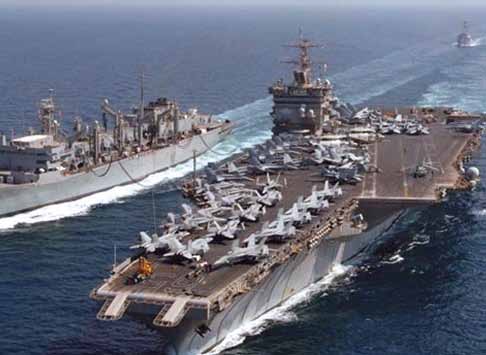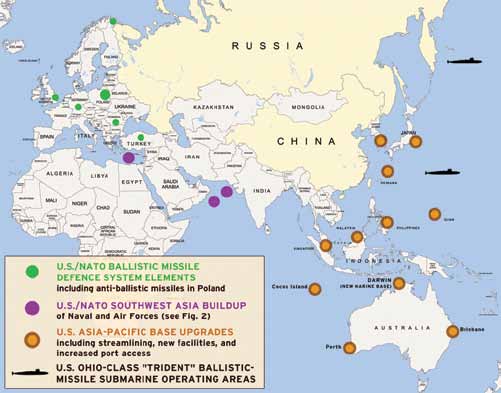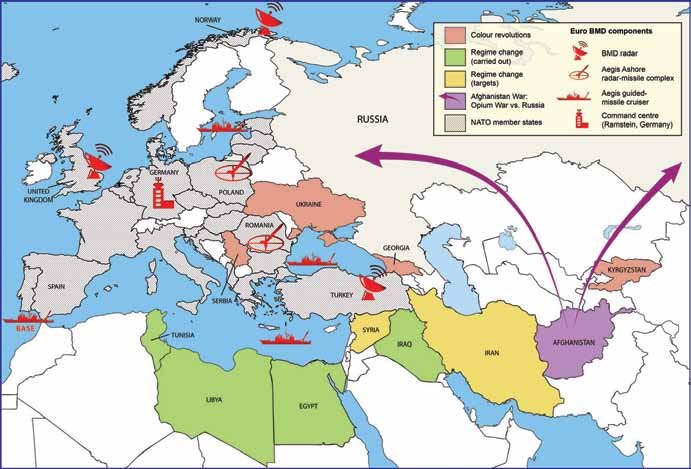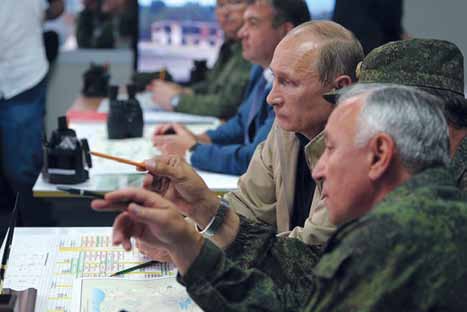It's Not Just Words:
Russian, U.S. Militaries in Action
September 2012
by Rachel Douglas and Nancy Spannaus

navaltoday.com
Russian media coverage described large-scale naval exercises in the Strait of Hormuz (shown here), aimed at Iran, as on a scale never before conducted there: “Muscle-flexing is in full swing, heated up by bellicose rhetoric,” noted Channel One. |
This article appears in the September 28, 2012 issue of Executive Intelligence Review and is reprinted with permission.
September 24, 2012—Those who choose to ignore the grim warnings of Lyndon LaRouche, Chairman of the U.S. Joint Chiefs of Staff Martin Dempsey, and the Russian leadership, about the imminent danger of a thermonuclear confrontation between Russia and the United States coming from the current U.S.-NATO regime-change efforts in the Middle East, need only look at the actual military deployments over the past month to see that danger. The escalation of outright military moves on both the U.S. and Russian sides, since the fateful murder of Libyan head of state Muammar Qaddafi, a little more than a year ago, has put the world on a pathway to destruction which must be derailed immediately, if mankind is to survive.
The Sept. 23 Sunday evening prime-time review of the week's news on Channel One, Russia's biggest TV network, provides a useful glimpse of this reality, from the Russian angle, and reveals its global implications. The show featured a seven-minute segment on the looming threat of war, focused on a threatened Israeli or U.S. attack on Iran, and included footage and maps of the Persian Gulf. Here are excerpts:
"This week preparations were under way in the Persian Gulf for the possible use of force. Judging by the concentration of military equipment, we may turn out to be just one step away from war. These exercises are taking place in the Strait of Hormuz, off the coast of Iran. A record number of warships, in the region's entire history, has assembled there—from over 30 countries, including the USA, Britain, and Saudi Arabia. Battleships, submarines, aircraft carriers, including Nimitz-class vessels with up to 70 fighter aircraft on board. The participants in these maneuvers do not conceal the fact that this show of force is addressed to Iran.... Maneuvers on such a scale have never before been conducted here.... Muscle-flexing is in full swing, heated up by bellicose rhetoric" (emphasis added).
At this point, Channel One showed the video clip of Israeli Prime Minister Netanyahu, saying that the United States "must stop Iran" from getting nuclear weapons, by drawing a "red line." "True, Washington replied that it will decide for itself whether to draw any red lines. But Israel is insisting, and hurrying them up," the commentator said.
After discussing various contingencies, such as Israel not wanting to start a war without the United States while Obama has electoral considerations, Channel One interviewed Alexei Arbatov of the IMEMO Center for International Security, a Russian establishment thinktank run by the Academy of Sciences, who said:
"The situation is extremely explosive. I would say that it is the most acute that it has been in the past 20 years."
While noting that leading U.S. military officers are arguing against getting into a new war, nonetheless, Russian TV said correctly, "Wars can begin through a provocation."
U.S.-NATO on the Move
The Russian TV description of the Strait of Hormuz maneuvers, the International Mine Countermeasures Exercise which began Sept. 16 and run through Sept. 27, is accurate. U.S. thinktank spokesmen, as well, have noted the extraordinary firepower being deployed in this maneuver.
While the minesweeping maneuver deliberately is not entering the Strait, an extremely crowded body of water where accidental encounter with the Iranians could well occur, that is no guarantee against such a conflict. An opinion piece by Washington Post senior columnist David Ignatius, "Lessons from an Iranian war game," underscored that point. Ignatius was permitted to observe the game, held in Washington, and including former top U.S. officials and prominent Iranian-American experts, and his conclusion, undoubtedly shared by the Joint Chiefs of Staff, was stark:
"The game showed how easy it was for each side to misread the other's signals."
For one thing, Ignatius puts President Obama, whom he assumes has been re-elected, directly on the side of war. But he leaves it to the reader to fill in the next step: that a U.S. strike on Iran's nuclear facility, be it conventional or nuclear, will inevitably bring in Iran's ally and northern neighbor, Russia.
U.S. and allied military deployments are not simply occurring around Iran, obviously. The move for regime change in Syria also represents a flashpoint for the Southwest Asia region, as Russia has repeatedly pointed out, and Col. Lawrence Wilkerson (ret.) elaborated in his answer to a question on the danger of World War III, in Rep. Walter Jones' press conference on Sept. 21 (see Feature). Israel itself, which cannot afford to take military action against Iran without American guarantees and backup, held surprise maneuvers on the border with Syria just last week.
And then there's the Asia-Pacific region, where the recent trip by Secretary of Defense Leon Panetta resulted in an escalation of tensions with China and Russia, over his announcement of an agreement with Japan on stationing another missile defense station in that nation. Allegedly, such "defense" stations are aimed at "rogue states," in this case North Korea, but, as Russian and Chinese commentaries have pointed out, Japan is in no danger from North Korea's capability. The only conceivable reason for such a deployment is to further the encirclement of China, and, as in the case of the encirclement of Russia, render that nation's defenses against a first strike impotent. It is for that reason that, in an unsigned Global Times editorial March 29, Beijing warned that "an overarching missile defense system would force China to change its long-held nuclear policy" of no first use of nuclear weapons.
There are also moves "on the ground" in Asia that, while they seem to be merely local skirmishes, could prove to be provocations for larger confrontations in the current superheated international climate, specifically, the conflict between Japan and China over the Diaoyu/Senkaku Islands.
Now, let's look at the Russian military preparations to deal with U.S./NATO moves.
| FIGURE 1 U.S./NATO Military Deployments Around Russia and China  The New Citizen
There are indications of Russian attention to the global scope of U.S. BMD planning, that is aimed against both Russia and China, as can be seen in this map. |
Russia Practices Response to 'External Attack'
Addressing Russian troops on Sept. 17, President Vladimir Putin spoke as commander-in-chief.
"You have had excellent training and are literate people," he told them. "You see what is going on in the world and how, unfortunately, the use of force in international affairs is increasing. All of this means that we must keep our powder dry. We must increase Russia's defense capabilities."
The occasion was the Kavkaz-2012 (Caucasus-2012) military maneuvers in southern Russia, which Putin had just observed. In addition to such statements, the very nature of these and other military exercises being held this Autumn, as well as the President's focus on the defense sector during current intense federal budget deliberations, also make clear that the Russian leadership assumes that its country is threatened, and could be involved in serious combat at any moment.
Meeting on Sept. 21 with Defense Minister Anatoli Serdyukov and Chief of the Armed Forces General Staff Gen. Nikolai Makarov, to review the just-concluded Kavkaz-2012 program, Putin termed it "a massive undertaking," which produced good results in testing command and control, as well as weapons systems. Serdyukov detailed that four different firing ranges in southern Russia were used, as well as sea and coastal areas on the Black Sea and the Caspian Sea. Most incisive was General Makarov's characterization of the exercises as having "two very serious challenges," one of them explicitly related to the tense situation in the region. One part of the scenario involved the potential deployment of the Armed Forces in conflicts within Russia, while the other was "resolving the problem of responding to an external attack."
Kavkaz-2012 was preceded, earlier in the month, by command-staff exercises of the Strategic Missile Forces. Taking place Sept. 4-7, they involved 150 command points and 300 individual weapons and other military equipment. The official news agency Itar-TASS reported, based on a press announcement made Sept. 4 by Ministry of Defense spokesman Vadim Koval, that the participants would "hone their nuclear deterrence objectives for the event of an armed conflict with the participation of Russia." The term "nuclear deterrence objectives" refers to the ability of Russia's Strategic Missile Forces to "deter" a possible U.S. nuclear first strike against Russia, by their ability to inflict a retaliatory nuclear strike against the United States.
Koval said that the scenarios involved "nuclear deterrence in the setting of a threatened armed conflict with Russia's participation, or during such a conflict." The purpose of this training, he added,
"is to improve coordination among Strategic Missile Forces command agencies, as well as the practical skills of the command staff and operational groups in directing the military command agencies, units, and troops subordinate to them, including through the use of modern automated command-and-control systems."
Long-Range Planning
The Russian decision to upgrade the particulars of these two, related sets of exercises—Kavkaz-2012 and the Strategic Missile Forces training—evidently followed close on the heels on two events in late 2011: the murder of Libyan leader Qaddafi in October; and then-President Dmitri Medvedev's public announcement in December, that diplomatic efforts to halt the U.S./NATO unilateral European Ballistic Missile Defense (Euro BMD) system from going ahead had been unsuccessful, that the Euro BMD was a strategic threat to Russia, and that it would be countered militarily.
By January 2012, Russian military sources were making it known that the September 2012 schedule of military exercises would feature complete, combined-arms integration. In particular, Nezavisimaya Gazeta's well-informed military analyst reported Jan. 17 that the Russian General Staff was mapping out "large-scale staff exercises based on a possible U.S.-Israeli attack on Iran"; this would happen in September, and would involve the Strategic Missile Forces. Furthermore, it was reported then, the script for Kavkaz-2012 would
"differ from last year's exercises in this series, by being larger-scale and more closely approximating actual current military and political conditions," including a scenario of "a possible war by the U.S.A. and several other countries against Iran, as well as other possible conflicts in the Caspian and Southern Caucasus region."
Throughout preparations for Kavkaz-2012, Russian defense sources described these exercises as "strategic." Russian and Georgian press reported that Russia had shifted the physical location of the training out of the Chechen Republic, in order to avoid giving Georgia's President Michael Saakashvili a pretext for any wild actions. On Sept. 5, RIA Novosti reported the announcement by another Russian Ministry of Defense spokesman, Alexander Kucherenko, that Russian airborne forces would be involved in 10 different exercises during the month, including Kavkaz-2012, and international maneuvers with Belarus and with the Collective Security Treaty Organization.
Countering Euro BMD
In an interview with Russia Today television, broadcast Sept. 6, Putin addressed an array of strategic matters, including the situation in Syria and in Southwest Asia as a whole. A recurring polemic in the interview was that people pushing various scenarios in crisis areas are hell-bent on their short-term schemes, "and hardly ever think of the consequences that will follow."
On strategic military relations, Putin said that the U.S. missile defense system now being deployed, particularly in Europe, "is surely one of the key issues on today's agenda, because it involves Russia's vital interests." He forcefully presented the Russian understanding that the Euro BMD system's "ambition is to upset the strategic balance, which is a very dangerous thing to do, as any party involved will always strive to maintain its defensive capabilities, and the entire thing could simply trigger an arms race." As for negotiations on alternatives to the unilateral U.S./NATO Euro BMD system, Putin said: "We did what we could," citing the Russian offers of a joint missile defense program. "Our partners are so far refusing to go along. What else can we do?"
| FIGURE 2 Ring Around Russia: Threats to a Great Power That Won’t Back Down  The New Citizen
President Putin told a conference on Strategic Nuclear that, “nuclear arms ... remain a truly important guarantee of Russia's sovereignty and territorial integrity, and play a key role in supporting global and regional equilibrium and stability.” |
Russia unquestionably is doing a number of things in response, militarily. Strategic Missile Forces chief Gen. Sergey Karakayev, who commanded the early-September command-staff exercises, told RIA Novosti on Sept. 3 that Russia will have a new intercontinental ballistic missile deployed by 2018, which is capable of penetrating the Euro BMD system. "It is necessary to note the new missiles' ability to be invulnerable before launch, thanks to their mobility, as well as their ability to tackle the task of defeating any possible missile defense system within the next 15-20 years, should such a need arise," General Karakayev stated. An article on the Russia Today website noted that Karakayev's comments show that Russia "is preparing an asymmetrical response by developing weapons capable of breaching the system."
There are also official and unofficial indications of Russian attention to the global scope of U.S. BMD planning, as being aimed against both Russia and China (while it is claimed that this is geared to Iran and North Korea).
Now, the Arctic
The issue of Asian, and even possible Arctic BMD deployments, came up in the Russian media, too, in connection with a naval deployment that jumped into the news Sept. 20, when a helicopter based on the nuclear-powered cruiser Pyotr Veliky, the flagship of the Northern Fleet, was totalled in a hard landing. What put the accident in the headlines was where it happened: in the Kara Sea along Russia's Arctic Coast, near Kotelny Island in the Novosibirsk Archipelago. The incident touched off intense public discussion, during which one retired military officer drew out the world-war implications of U.S. ship-based anti-missile deployments to Russia's north.
In the past, large surface ships have ventured into this region only if accompanied by an icebreaker, but lower Arctic ice levels have allowed the Northern Sea Route to be used more freely. For decades, surface ships of the Northern Fleet have left Murmansk only to the west, into the Atlantic, never sailing eastward along the Arctic coast. According to an article by Victor Savenkov for Svpressa.ru, the last time a large battleship was in the Kara Sea region was August 1942, when a German heavy cruiser sank the Soviet icebreaker Alexander Sibiryakov.
Svpressa.ru interviewed Russian naval experts on what the Pyotr Veliky's mission might be in the Kara Sea, given that it is not an antisubmarine warfare platform, and the type of surface ships it would potentially engage do not frequent the Arctic coast. Adm. Valentin Selivanov (ret.), former commander of Russia's Mediterranean Squadron, said that, besides taking advantage of the weather to reach relatively nearby training areas that were not previously so accessible, a major factor was
"to demonstrate that we are prepared to defend our interests in the Arctic militarily."
Col. Anatoli Tsyganok, director of the Center for Military Forecasting, told Svpressa.ru that another reason might be the deployment of U.S. Aegis-equipped ships in the Arctic, which would position them within striking distance of "the shortest trajectories of our ICBMs to the USA." The Aegis radar/anti-missile system is the main component of the U.S. Euro BMD program, which Moscow identifies as a threat to its strategic nuclear deterrent. "It is not to be excluded," said Tsyganok, that the Pyotr Veliky's cruise is related to such concerns. "The Americans are developing their BMD system in the north, just as in the south. Aegis-equipped ships regularly enter the Bering Strait," he asserted.
"This is a threat to our security. Because it's one thing if BMD-equipped vessels appear along our southern borders and in the Mediterranean, but in the event of war, Russian missiles will fly to the USA across the North Pole. So it's another matter altogether, when such ships show up to the north of our country, and seek the ability to shoot down our missiles in the most vulnerable, boost phrase."
Prioritizing Military Industry
 Presidential Press and Information Office
Russian President Putin, addressing troops Sept. 17, on the occasion of the Kazkav-2012 military exercises, noted somberly, “You see what is going on in the world and how, unfortunately, the use of force in international affairs is increasing. . . . We must increase Russia’s defense capabilities.” Putin is shown here (center), observing the exercises. |
In July, Putin held meetings at his Summer residence in Sochi, and took tours to key military areas, for discussions on putting the Russian military-industrial complex into shape. On July 26, he met with officers and officials in charge of Russia's Strategic Nuclear Forces and Aerospace Defense Troops. Deputy Prime Minister Dmitri Rogozin, Minister of Industry Denis Manturov, Roscosmos head Gen. Vladimir Popovkin (ret.), and the director of the nuclear agency Rosatom, Sergei Kiriyenko, were in attendance, along with Ministry of Defense representatives. The Kremlin's announcement called it a "Meeting on Implementation of the State Armaments Program for Nuclear Deterrence," a reference to the thermonuclear weapons that would be fired at the United States and its allies in the event of an attack on Russia.
Earlier, Putin held conferences on implementing the government's Ground Forces and Air Force programs. The session on the Strategic Nuclear Forces was highlighted on national TV, including Putin's statement that "nuclear arms ... remain a truly important guarantee of Russia's sovereignty and territorial integrity, and play a key role in supporting global and regional equilibrium and stability." Citing the need for the aerospace defense system to be "in a constant state of combat readiness, taking into account potential enemies' plans for developing offensive measures," Putin noted that "nearly all the nations that possess nuclear weapons and aerospace assault weapons are working to improve and develop them.
Russia, he said, has no plans to engage in an arms race, "but there should be no doubt as to the reliability and efficacy of our nuclear potential, as well as our aerospace defence system." He said that "a significant part of financial resources within the state armament program" will be allocated to upgrading the Strategic Nuclear and Aerospace Defense Forces.
"By 2020 the share of modern weapons in our Strategic Nuclear Forces should be at 75-80%, and for Aerospace Defence Troops this figure should be no less than 70%."
On July 30, Putin traveled to the northern city of Severodvinsk in the Arkhangelsk Region, to speak at a ceremony marking the beginning of construction of Russia's fourth Borey-class nuclear ballistic-missile submarine, and to preside over a meeting on the future Navy construction program. In his remarks, Putin mentioned both the naval component of Russia's strategic nuclear forces, and the rebuilding of other components of the Navy to defend areas such as the Arctic. The program calls for investing about 4.5 trillion rubles (nearly $150 billion) over the next several years, for the construction of 51 modern surface warships, 16 nuclear attack submarines, and 8 nuclear ballistic missile submarines by 2020 (2 of which are now undergoing trials). This will allow the share of modern vessels and equipment in the Navy to be brought to 70% by 2020, Putin said. "Resuming the serial construction of new-generation ships," he added, "should go hand-in-hand with modernizing shipbuilding enterprises and other defense industry companies."
After these sessions devoted to each of the branches of the Russian Armed Forces, Putin on Aug. 31 held a pair of conferences on the strategic dimensions of economic policy. With Russian government and State Duma deliberations set to resume in September on the 2013 budget, under enormous monetarist pressures for budget-cutting because of the world economic crisis, Putin focused on the absolute priority of restoring Russia's military-industrial sector. Thus, these sessions on military-economic policy also served to underscore the tense international military-strategic situation.
Addressing an expanded session of the Russian Security Council, Putin presented the military modernization plans as "ambitious," and cited the "record amounts of money" to be invested in defense procurement and modernization: 23 trillion rubles ($750 billion) over ten years. He acknowledged that "many of our companies are still in the past century, technologically speaking," and that in the course of more than three decades, the defense production plants "have missed out on several modernization cycles." Later in the day, Putin met with Deputy Prime Minister Rogozin and Roscosmos head Popovkin to discuss personnel changes to address the recent rocket-launch failures.
At the Security Council meeting, Putin also emphasized the idea, often stated by Rogozin, that the military-industrial sector should function as a locomotive to pull the whole economy along—or, at the very least, serve as a safe haven, where engineering and other skilled personnel might be preserved, even as domestic industry as a whole comes under new pressures such as competition from foreign imports, now that Russia has joined the WTO, and budget cuts in the so-called "state order" (government contracts).
Regarding this potential interface between the defense industry and the economy as a whole, the problem that bedeviled Soviet planners throughout the Cold War, Putin said:
"Our position is that by creating a modernized and effective defense industry we can ensure a big growth potential for the entire national economy. The bulk of our advanced technology is in the defense industry, and civilian goods account for more than 30% of the sector's total output. There is steady demand for these goods in the energy, metals, machine-building, communications, and other industries. This is not some discovery we have made in this country, but is the way things work all around the world. The defense industry has always been an engine pulling the other manufacturing sectors along behind it. Of course, a stable and effective defense industry is also crucial for the prosperity and prospects in life for thousands of skilled workers, engineers, and designers. The defense industry brings together 1,353 organizations and companies in 64 regions of the country, and employs more than 2 million people. Just think how many that makes if you add their families and the people working in related sectors and so on."
Summarizing, Putin made a startling comparison with the period of the Soviet Union's first Five-Year Plans: "In short, we will have to modernize the entire defense industry and the way it works, and carry out the same kind of comprehensive and powerful modernization drive that was achieved in the 1930s." The implications were not drawn out in this presentation, but such a "mobilization economy" is very different from the nostrums about privatization and "improving the investment climate," which are otherwise being repeated constantly by Russian officials, including Putin.
Putin said Russia should not hesitate to imitate foreign defense technologies, but having only assembly plants using imported components would be a "dead end," so Russia
"should develop complete production cycles, from development through to mass production and spare parts supply, here in Russia. This is the guarantee of our national, technological, and defense security."
